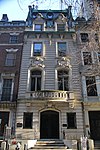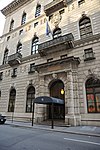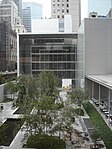5 West 54th Street

5 West 54th Street (also the Dr. Moses Allen Starr Residence) is a commercial building in the Midtown Manhattan neighborhood of New York City. It is along 54th Street's northern sidewalk between Fifth Avenue and Sixth Avenue. The four-story building was designed by R. H. Robertson in the Italian Renaissance Revival style and was constructed between 1897 and 1899 as a private residence. It is the easternmost of five consecutive townhouses erected along the same city block during the 1890s, the others being 7, 11, 13 and 15 West 54th Street. The first floor is clad with rusticated blocks of limestone, while the other floors contain buff-colored brick trimmed with limestone. The house was commissioned for neurologist Moses Allen Starr, who lived there until he died in 1932. His widow Alice continued to live there until she died in 1942. The next year, Robert Lehman bought the residence and lent it to Freedom House. The house was used as a veteran's retreat after World War II. It was used as the offices of Faberge Inc. from 1948 to 1970 and by John S. Lastis Inc. after 1974. The New York City Landmarks Preservation Commission designated the house as an official landmark in 1981, and it was added to the National Register of Historic Places in 1990 as part of the 5–15 West 54th Street Residences historic district. As of 2018, the house contains a boutique, The Curated NYC, operated by Christian Siriano.
Excerpt from the Wikipedia article 5 West 54th Street (License: CC BY-SA 3.0, Authors, Images).5 West 54th Street
West 54th Street, New York Manhattan
Geographical coordinates (GPS) Address External links Nearby Places Show on map
Geographical coordinates (GPS)
| Latitude | Longitude |
|---|---|
| N 40.7615 ° | E -73.976 ° |
Address
West 54th Street 5
10019 New York, Manhattan
New York, United States
Open on Google Maps









